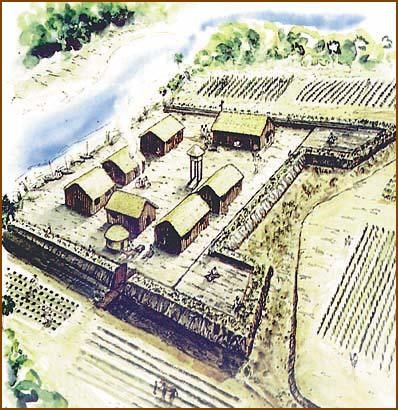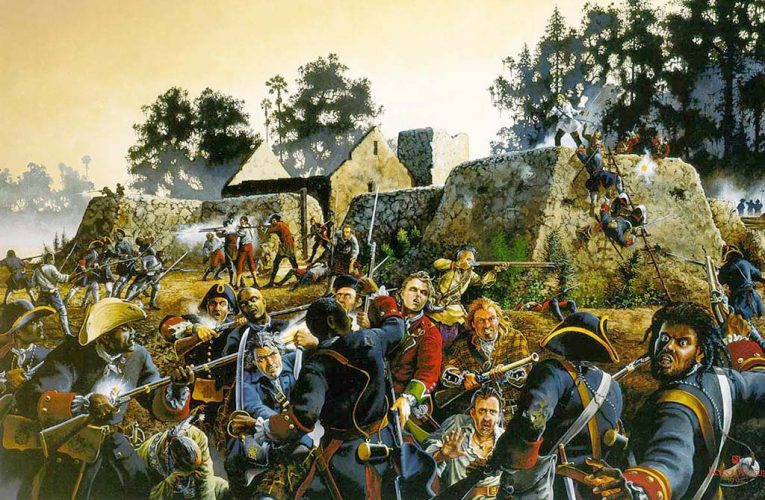Established in 1738, Gracia Real de Santa Teresa de Mose (Fort Mose) is the site of the first legally sanctioned free Black community in what is now the United States and was home to approximately 100 free men, women, and children.
Fort Mose was the destination of the original Underground Railroad — a perilous 300-mile journey from enslavement in British colonies in the Carolinas and Georgia to sanctuary in Spanish St. Augustine. En route, freedom seekers were aided by Native allies. Upon their arrival, freedom seekers were offered asylum, provided they swear allegiance to the Spanish crown, adopt the Catholic religion, and (for the men) entered a term of service in the Spanish military.
Fort Mose served as the northernmost defensive outpost for Spanish St. Augustine. It was staffed by a free Black militia and led by the free Black Captain, Francisco Menendez.

The European imperial powers of Britain and Spain vied to achieve geopolitical, commercial, and cultural dominance within the Western Hemisphere, resulting in the War of Jenkins’ Ear from October 1739 to October 1748. Britain and Spain went to war over access to markets in Spanish America with disputes mainly occurring in New Granada (modern-day Colombia), the Caribbean, Atlantic and Pacific Oceans, and seeped into Spanish Florida and British Georgia.
The war is named after an incident that occurred in 1731 off the coast of Florida. The British brig Rebecca was boarded by a Spanish privateer named Juan de León Fandiño, commander of a patrol boat named La Isabela.
Reportedly, Fandiño cut off Captain Robert Jenkins’ left ear and accused him of smuggling. In March 1738, Jenkins was ordered to testify before British Parliament. According to some accounts, Jenkins produced his severed ear pickled in a jar as part of his presentation.
The Siege of St. Augustine was a conflict within the War of Jenkin’s Ear which, by 1740, had continued for about a year in the Caribbean.
The war reached North America with the Siege of St. Augustine. James Oglethorpe, Governor of the British colony of Georgia, led the ferocious campaign. He began by raiding Spanish forts along the St. Johns River west of St. Augustine — Fort San Diego, Fort Picolatta, and Fort San Francisco de Pupo.
In May 1740, Oglethorpe launched a substantial expedition intended to encircle, besiege, and capture St. Augustine, the seat of the Spanish government. A British naval squadron blockaded the port, while Oglethorpe deployed soldiers on Santa Anastasia island.
Once the City was surrounded, Oglethorpe began bombarding the Castillo de San Marcos with heavy fire. For nearly a month, the Castillo cannons and long-range harbor galleys held the enemy at bay. Sheltered within the Castillo walls, the citizens of St. Augustine remained safe. However, food and munition supplies ran dangerously low and the situation grew dire.

When Spanish Governor Montiano first learned that the British were approaching St. Augustine, he issued an evacuation order for Fort Mose. The Mose militia and all Mose citizens were moved to the Castillo de San Marcos.
Before leaving Mose, the Mose militia destroyed the fortress by tearing off its gates and boring holes in its walls. Nevertheless, the British army set up camp within the damaged structure. This was their fatal mistake.
Before dawn, a fierce coalition of Spanish troops, Fort Mose militia, and Native allies waged a counter-offensive, attacking the British in their sleep. Taken by surprise, the British found no time to prepare their weapons. A brutal ‘bloody battle’ ensued, including gunfire and hand-to-hand combat with swords, muskets, and clubs. In less than an hour, the Spanish forces led by Captain Antonia Salgado and Mose militia with Native allies led by Captain Francisco Menendez emerged victoriously.
Days later, Spanish reinforcements arrived in St. Augustine from Havana. During the Battle of Bloody Mose, Oglethorpe had lost much of his Highlander regiment and was now outnumbered and dangerously low on supplies. He retreated to Georgia and St. Augustine remained under Spanish control until 1763. The brave citizens of Fort Mose remained free, just as the Spanish had promised.
Visitors are welcome to see the annual reenactment of the Battle of Bloody Mose at Fort Mose Historic State Park. Two battles take place at 11 AM and 1 PM with additional activities from 10 AM to 3 PM like musket demonstrations, blacksmithing, weaving, and children’s activities.
This event is free, but admission to the museum is $2 with plenty of parking available on-site.